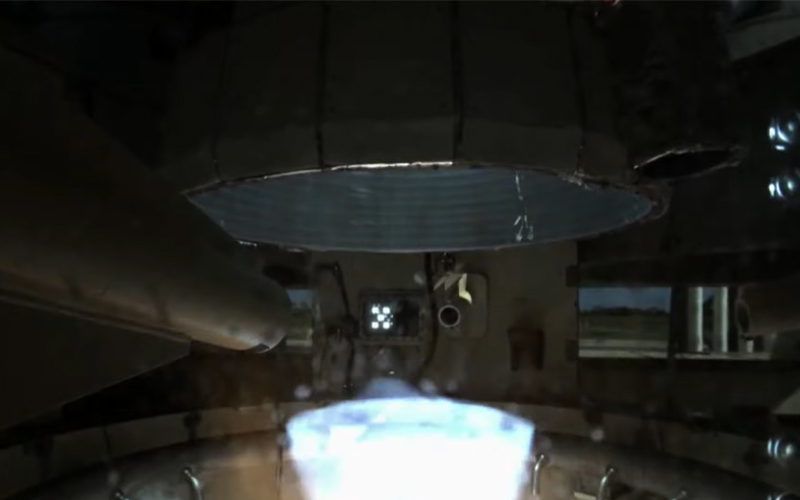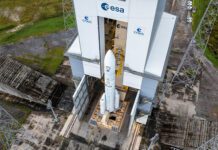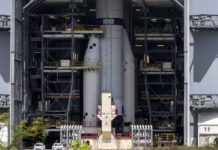
ESA, the French Space Agency CNES, and project prime ArianeGroup completed the first shot hot fire test of an Ariane 6 core stage.
The test was completed in the late afternoon on 5 September from the Ariane 6 ELA4 launch complex of the Guiana Space Centre. The testing involved a full launch sequence and final countdown, which included the removal of the mobile gantry and filling of the launcher’s upper and core stage tanks with liquid hydrogen and liquid oxygen. The test was concluded following a short four-second firing of the Ariane 6 Vulcain 2.1 engine.
“The H0 was engaged exactly on time, not a single second of delay, proving the very high level of maturity that we have achieved together,” explained Ariane 6 programme director at ArianeGroup François Deneu in a LinkedIn post. “There is no magic, it is not “by chance” that we succeeded yesterday. This is the result of important efforts in designing the launcher, manufacturing, integrating testing, and delivering a test specimen very similar to the flight model.”
ESA had initially planned to complete the short hot fire test in July. However, the test was interrupted due to “certain measurements exceeding preset limits,” the agency explained in a statement. A second attempt during the same test campaign had to be abandoned because of a lack of liquid oxygen.
A rescheduled test was then set for August 29, which had to be postponed due to a “technical issue affecting the control bench.” However, during a briefing on September 4, the director of space transportation at CNES, Carine Leveau, explained that there was no “clear technical issue” with the control bench. However, the team did need more time to ensure it was ready for the test.
The next major step in the Ariane 6 test programme is the long-duration core stage hot fire test that is expected to occur on 3 October. It will include a 470-second burn of the Vulcain 2.1 engine, which represents the full flight phase of an Ariane 6 core stage. The test had been scheduled for late September but was likely rescheduled due to the delay of the short hot fire test.
After the core stage test, a third second stage test will be conducted in Lampoldshausen, Germany towards the end of the year. This test will see the engine being fired under degraded conditions.
The maiden flight
During the 4 September briefing, ESA Director General Josef Aschbacher explained that the agency would announce when the maiden Ariane 6 flight would occur following the completion of the long-duration hot fire test in early October.
The flight will not only carry a simple mass dummy payload. In November 2021, ESA announced an opportunity for European commercial and institutional payloads to catch a ride to low Earth orbit. The announcement stated that the mission would host payloads of no more than 80 kilograms with an aggregated mass of no more than 800 kilograms. Although the opportunity was open to all, priority was given to payloads from ESA member states that contributed to the development of Ariane 6.
In February 2022, ESA announced the payloads that would fly aboard the maiden Ariane 6 flight. The payloads were split into two categories. The first category included payloads with a mass of 0.15 to 12 kilograms that will be fixed to the top of the mass dummy. These experiments are expected to collect valuable data up to the end of the mission when the upper stage reenters Earth’s atmosphere.
- PariSat (Garef Aerospatial) – An experiment to confirm black-body radiation theory.
- Peregrinus (Sint-Pieterscollege) – A dual sensor magnetic field.
- SIDLOC (Libre Space) – A demonstrator for a radio frequency beacon.
- ESA YPSat – Eye2Sky (ESA) – Cameras to capture photos and video footage.
The second category of payloads that will be flown aboard the maiden Ariane 6 flight are small spacecraft with a mass of between 1.3 and 40 kilograms.
- Bikini Demo (The Exploration Company) – A small technology demonstrator of company’s reentry capsule.
- SpaceCase SC-X01 (ArianeGroup) – A test platform for reentry technologies, including a new-generation ablative material for thermal protection systems.
- OOV-Cube (TU Berlin) – An IoT agriculture use case demonstration microsatellite.
- 3Cat4 (ESA Education Office/Technical University of Catalonia) – A technology demonstrator 1U CubeSat that will test a flexible microwave payload.
- ISTSAT (ESA Education Office/University of Lisbon) – A 1U CubeSat that will characterise an aircraft’s ‘cone of silence.’ It will also test the in-flight performance of an Automatic Dependent Surveillance-Broadcast system.
- Spacemanic (GRBBeta) – A 1U CubeSat carrying a Gamma Ray Burst detector.
- CuriumOne (PTS) – The primary payload is a duplicate of the ASTRIS Engineering Qualification Model PCB.
The flight will also feature two deployers, one from Spain’s UARX Space and the other from Germany’s ExoLaunch.
Once a maiden flight has been completed, the first operational flight of Ariane 6 will follow. At the 4 September briefing, DG Aschbacher explained that the flight would take place approximately six months after the maiden flight, assuming the mission is completed without issue.




